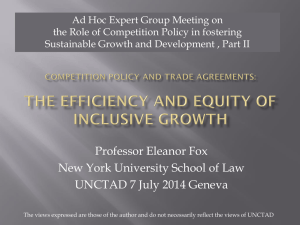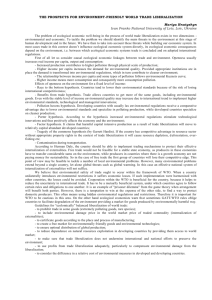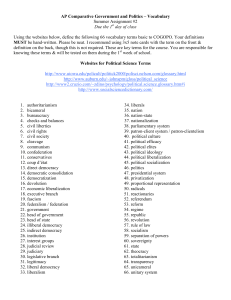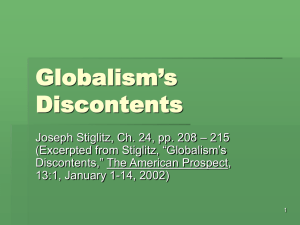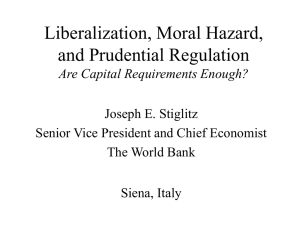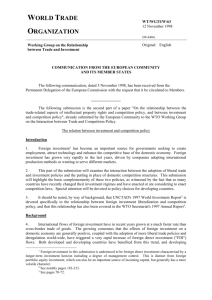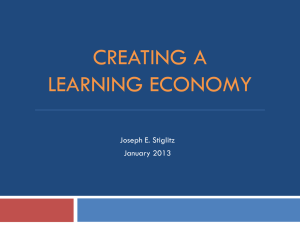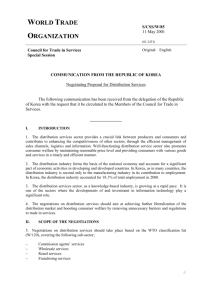Paper n°12 (pdf, it, 1033 KB, 5/15/13)
advertisement
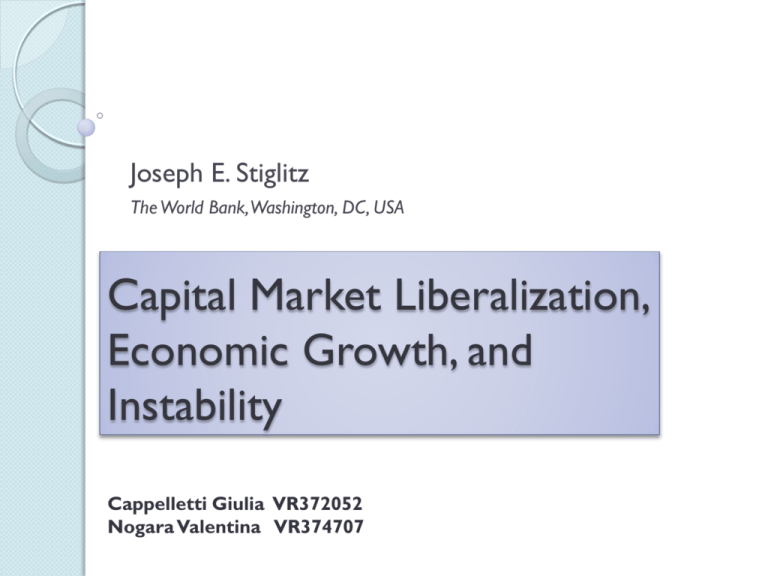
Joseph E. Stiglitz The World Bank, Washington, DC, USA Capital Market Liberalization, Economic Growth, and Instability Cappelletti Giulia VR372052 Nogara Valentina VR374707 INTRODUCTION In this paper the author focuses its analysis to review the arguments for capital market liberalization by the identification of theoretical end empirical weaknesses of the modern economic system. This will provide the foundations to define the implementation of the interventions in term of short-term speculative capital flows. INTERVENTION Indicate a fairly general term, because not all intervention are identical. For instance, some form of intervention may not bring benefits commensurate with their costs. The central arguments in this paper is that exist some form of intervention that are likely to be welfareenhancing. INTRODUCTION Nowadays the economic scenario present one of the worst financial and economic crisis since the Great Depression in 1930. Crises have become more frequent and severe. Even countries with good economic policies and stable institutions were affected. Large part of crisis and changes in capital flows were influenced by event outside the country (such changes in interest rates). INTRODUCTION It has become increasingly clear that the core of the problem of the financial and market capital liberalization was the need to be regulated by an effective regulatory framework. CASE OF EAST ASIA CRISIS: data estimated in 1999 by the World Bank of the five emerging economies (Korea, Malaysia, Thailand, Philippines), presented an output of 17% below what it would have been had the growth trend of the 10 years before the crisis. Instead the two large developing countries, India and China, countries with a strong control of capital flows, survived at the crisis and continued their rise. INTRODUCTION The RHETORIC argument with which the crisis was begun, that globalization, liberalization and market economy delivered its fruits just to virtuous countries was re-examined. At the same time, is clear that there is not only no case for capital market liberalization, but there is a compelling case against full liberalization. International financial community came so close to adopt a position that could not be justified in the basis of theory, in itself provide an important cautionary note, over reforming the international economic structure. Clearly before these reforms are adopted, there needs to debate, but the problem is that developing countries often have not a formal membership in some of the circles where these pivotal issues are being discussed. The ANALITIC argument, that analyzed the same phenomenon, were subject to greater scrutiny. INTRODUCTION The author in this paper would focalizes his attention on short term speculative capital flows. For instance, foreign direct investments brings in the country: Resources Technology Access to the markets Human capital It is a form of investment more stable then the short term flows that can rush into a country and as precipitously rush out. The variation in flows can be enormous: % OF FLOW RAPPORTED TO GDP (1996 -1997) THAILAND 14 SOUTH KOREA 9 EAST ASIA 10 (For an ammount of 105 billion $) THE CASE FOR CAPITAL MARKET LIBERALIZATION The case for capital market liberalization is largely based on some standard efficiency arguments, developed through the use of the neoclassical model, and ignoring the special ways in which financial and capital markets differ from markets for ordinary goods and services and the distributional consequences. The author focuses his attention to evaluate the case more on its own terms, that is, the case that capital market liberalization leads to obtain higher output and greater efficiency. THE CASE FOR CAPITAL MARKET LIBERALIZATION The five components to the argument are: 1. Countries should be concerned with maximizing GNP, not GDP. Therefore, if the citizens of a country can find an outlet for their funds with a higher return than any investment in their country, then GNP is maximized by allowing the funds to leave the country. 2. International competition for funds provides a needed spur for countries to create an economic environment attractive to business. THE CASE FOR CAPITAL MARKET LIBERALIZATION 3. Open capital markets help stabilize the economy through diversification. As a country faces a downturn, the lower wages will attract funds into the country, helping to stimulate it. This was a central argument for capital market liberalization in East Asia. 4. On the other hand, for much of the rest of the world, open capital markets were important as a source of funding for needed investment projects. 5. The case for opening capital markets was made by way of analogy to free trade in goods and services. A central tenet in economics, at least since Adam Smith, was that free trade was beneficial to a country. THE CASE FOR CAPITAL MARKET LIBERALIZATION The Evidence The predictions of the advocates of capital market liberalization are clear, but unfortunately, historical experience has not been supportive. GROWTH The author consider a wealth of cross country studies supporting the view that trade liberalization leads to faster economic growth (A) (See, e.g. Sachs and Warner [1995], Wacziarg [1998], and Vamvakidis [1999]). For instance, the following graphic, borrowed from Danny Rodrik’s study, shows growth in different countries related to the openness of capital markets, as measured by the IMF. (This is particularly important, because it provides a metric which corresponds to the kinds of actions which the IMF might have taken in attempting to open up the capital markets.) Partial scatter plot relating economic growth to capital-account liberalization Partial scatter plot relating investments/GDP to capital account liberalization. The indicator of capital account liberalization is the proportion of years during 1975-89 for which the capital account was free of restrictions. The sample covers almost 100 countries, developing as well as developed. The following controls are used in each scatter plot are: initial percapita GDP, initial secondary enrollment rate, an index of the quality of gov. institutions, and regional dummies for East Asia, Latin America, and sub- Saharian Africa. THE CASE FOR CAPITAL MARKET LIBERALIZATION (B) STABILITY The global economic crisis has centered attention around another aspect of economic performance, the stability. Several Researches has shown that instability has persistent effects on economic growth, because growth is slowed down for several years after a crisis has occurred. Indeed, the unit literature suggests that an economy that suffers a large fall in output never fully recovers, output remains persistently below what it would have been. INSTABILITY often created consequences in term of distribution, particularly in Developing countries, due to the inadequate or nonexistent safety nets. THE CASE FOR CAPITAL MARKET LIBERALIZATION For instance, the recent crises have amply demonstrated this burden, with unemployment increasing from 3 to 4% in Korea and Thailand (and by more in Indonesia), and with real wages falling l0% in Korea, and by as much as a quarter in Thailand and Indonesia. It is clear that not only is there no compelling empirical case for capital market liberalization, there is a compelling case against capital market liberalization, at least until countries have found ways of managing the adverse consequences. WHY CAPITAL MARKET LIBERALIZATION PRODUCES INSTABILITY, NOT GROWTH (A) FALLACIES IN THE STANDARD ARGUMENTS Financial and capital markets are essentially different from markets for ordinary goods and services - The central function of financial and capital markets is information-gathering - Information markets ≠ “ordinary” markets - So, the argument for capital liberalization that is exactly the same as the argument for trade liberalization is false! WHY CAPITAL MARKET LIBERALIZATION PRODUCES INSTABILITY, NOT GROWTH Opening capital markets allows for diversification and thereby enhances stability? Capital market liberalization is associated at greater instability: - capital flows are remarkably procyclical thereby aggravating the economic fluctuations This is consistent with the popular adage about bankers: WHY CAPITAL MARKET LIBERALIZATION PRODUCES INSTABILITY, NOT GROWTH - In addition, with an open market, countries are exposed to changes in economic situations outside the country this can lead to huge capital outflows So, there is a shortage in the third standard argument. WHY CAPITAL MARKET LIBERALIZATION PRODUCES INSTABILITY, NOT GROWTH Governments should be concerned with GNP: This argument has some validity but misses a central issue in development: there are a lot of reasons for which investors do not appropriate the full value of their contributions: - Returns to scale - Network externalities - Taxes on capital that may carry at an excees of social benefits from investing at home respect private benefits WHY CAPITAL MARKET LIBERALIZATION PRODUCES INSTABILITY, NOT GROWTH Capital market liberalization provides additional sources of funding: this is questionable 1. Does more short-term capital provide a basis for investment? 2. Do restrinctions on short-term capital flows discourage foreign direct investment or other forms of longer term investment? The answer at the 2 questions appears to be NO. WHY CAPITAL MARKET LIBERALIZATION PRODUCES INSTABILITY, NOT GROWTH As already seen, China is the country that has been the most successful in recruiting foreign direct investment by the imposition of an high level of restrinctions on short-term capital flows. Also other countries (Chile, Malaysia) that have imposed restrinctions on short-term flows, have not had their long-term flows adversely affected. But capital market liberalization is associated with greater economic volatility and a higher probability of recession makes investment less attractive. WHY CAPITAL MARKET LIBERALIZATION PRODUCES INSTABILITY, NOT GROWTH The argument that opening the capital account is important to enhance a flow capital into the country was reversed: it causes capital flight and the weakening of economy. According to Stiglitz, opening the capital account imposes “discipline”to the countries: - good economic policies (to support FDI) - strong political process - economic stability WHY CAPITAL MARKET LIBERALIZATION PRODUCES INSTABILITY, NOT GROWTH (B) WHY CAPITAL ACCOUNT LIBERALIZATION HAS NOT CONTRIBUTED TO GROWTH Capital market liberalization, as seen before, can lead to greater instability with negative effects on economic growth, discouraging investment and facilitating the flow of capital out of the country. Nowadays countries are encouraged to maintain enough reserves to protect themselves from volatility in international financial markets. There is a key indicator, called short-term indebtness. When this indicator falls below unity, countries are affected by crisis, as happened in the recent global financial crisis. WHY CAPITAL MARKET LIBERALIZATION PRODUCES INSTABILITY, NOT GROWTH Now, for instance, we consider a poor developing country: - In this country there is a company that borrows $100 million from a US Bank that charges him 20% - The country has to add $100 million to reserves (held in US T-bills). If we look at the country’s balance sheet, we note that the country hasn’t a new net capital, it lend and borrow from US the same amount. But it pays to the US every year $20 million in interest, while it receives from the US $5 million (interest on the T-bill). Clearly, this is good for US, but is hardly the basis for more rapid growth by the poor developing country. WHY CAPITAL MARKET LIBERALIZATION PRODUCES INSTABILITY, NOT GROWTH In conclusion, restrictive monetary and fiscal policies resulted in deep recessions or depressions. Firms will view debt financing as highly risky, so will have to limit expansion to what they can largely self- finance, with strong adverse effects on longterm economic growth. THE CASE FOR INTERVENTION • Once one recognizes that short-term capital flows can give rise to economic instability there is a compelling case for intervention. • There is a marked discrepancy between private and social returns and risks. • The capital flows impose a huge negative externality; the crisis has affected many others besides the borrowers and lenders, such as workers and small businesses. • Ironically IMF’s decisions (to increase interest rates in order to avoid the adverse effects on firms who had uncovered foreign denominated borrowings) increased the magnitude of the externality. THE CASE FOR INTERVENTION An example of the costs of externality can be seen through the prudential reserve management policies described earlier. • These huge costs might have benefited other uses of funds ( to build schools, health clinics, roads..) • The private decision to borrow has imposed a high negative cost on society. • The natural reaction of economists is to impose a “tax” to correct the externality. • Such taxes might discourage some capital flows, but firms should be made to pay the full social cost of their activity reducing those that create negative externalities. • THE CASE FOR INTERVENTION The consequences of externalities may depend on the situation of the country: DEVELOPED COUNTRIES - Automatic stabilizers - Strong safety nets - Countercyclical fiscal policy DEVELOPING COUNTRIES - No automatic stabilizers - Constraints that exasperate fluctuations - Pro-cyclical fiscal policy - Some policies recommended may make matters worse Can absorb the shock better Weak financial institutions may make a country particularly vulnerable to large and sudden changes in shortterm flows THE CASE FOR INTERVENTION The importance of these externality effects associated with short-term flows, has constituted the major shift in thinking in discussions over the international financial architecture. During the World Bank and IMF Annual Meetings in Hong Kong in October 1997, there was a call for a change in the IMF charter to push through the agenda of capital account liberalization, accompanying this proposal by several caveats. Liberalization required strong and stable financial institutions: a strong regulatory framework would have to be in place as prerequisite. THE CASE FOR INTERVENTION Even advanced industrialized countries have found it difficult to establish strong financial institutions and effective regulatory structures. Crises can easily occur in countries with a high degree of transparency (e.g. financial crises in Scandinavia and the United States). So, the caveat that developing countries should have strong financial institutions and regulatory structures in place before liberalizing their capital accounts suggests that the entire question is now moot! The market failure analysis calls into question the fundamental premises underlying the capital account liberalization. DESIGNING EFFECTIVE INTERVENTIONS It is known that some form of intervention might be desirable in principle, but can exists interventions that are effective and that do not have adverse ancillary effects. The purpose of the stabilizing interventions is to equate social and private costs and to stabilize the short-term flows. More recently, attention has focused on three sets of interventions: ◦ restrictions on capital inflows ◦ restrictions on capital outflows ◦ restrictions imposed on the banking system DESIGNING EFFECTIVE INTERVENTIONS (A) CAPITAL INFLOWS Chile has imposed what amounts to a tax on short-term inflows. In doing so, it has succeeded in stabilizing these flows, without adversely affecting the flow of long-term productive capital. Incidentally, even a tax on capital inflows can serve to stabilize outflows. Those who seek quick returns by taking their money out for a brief time in the hopes of a devaluation, and then bringing it back, are made to pay a high price for this round trip. CRITICS: some have interpreted Chile’s actions in the recent crisis, where the tax rate was set at zero, as an abandonment by that country of this of this policy. STIGLITZ: The point of the tax is to stabilize the flow to discourage excess inflows when that appears to be the problem. But in the global financial crisis, no developing country faced excess inflows. Indeed, it might even be conceivable that, faced with a shortage of inflows, the country might have a negative tax. But the tax structure is in place: if global financial markets recover, as they almost surely will, and the country again faces an excess of capital inflows, then the tax rate could again be raised. DESIGNING EFFECTIVE INTERVENTIONS (B) CAPITAL OUTFLOWS Malaysia tried a quite different experiment: controls on the outflow of capital. Recently, the country moved to a more market-based exit tax. It is too soon to evaluate the experiment, but preliminary results suggest that it has been far from the disaster that was predicted. The removal of the tax went smoothly, the country used the time provided to make significant progress in financial and corporate restructuring, and foreign direct investment continued at a relatively strong pace. The country used the greater freedom that it afforded in the conduct of monetary and fiscal policy to reduce the magnitude and duration of the downturn and the legacy of public debt. DESIGNING EFFECTIVE INTERVENTIONS (C) REGULATING CAPITAL FLOW TROUGH THE BANKING SYSTEM Observers of the crisis, however, noted that focusing on the financial system may not be enough; after all, two-thirds of the foreign-denominated borrowing in Indonesia was by corporates. If foreign banks were offering highly favorable terms, the pressure for foreign borrowing would show up somewhere else in the system. Improved banking regulation might limit direct weaknesses in the banking system. STIGLITZ: This perspective ignores the central role that the financial system plays in the economy, and the ability of government to exercise effects through the regulation of the banking system. Governments can and should insist that banks look at the uncovered exposure of firms to whom they have lent. For that (uncovered) exposure can affect greatly the likelihood that the firms to which they have lent will not be able to repay their loans. DESIGNING EFFECTIVE INTERVENTIONS In principle the bank regulations can be market based: • Bank regulators could impose risk weights in the capital adequacy requirements, so that loans to firms with high exposure received higher risk weights. • Thus, banks would only make loans to such firms if they received an interest rate high enough to compensate them for the higher costs (and risks). CONCLUSIONS It emerged the need for a discussion of a new global economic architecture: attention should be focused on preventing future crises and making them less frequent and less deep. 2. It was observed that the last major set of crises occurred in transparent countries (Norway, Sweden..), instead many countries that were less transparent did not have a crisis. 3. Reforms have to focus on fortification of financial institutions. 4. The one area in which there is an emerging consensus, for a change in perspectives, is short-term capital flows. 1. CONCLUSIONS “Freedom has it risks! Let’s go then for an orderly liberalization of capital movements...the objective is to foster the smooth operation of international capital markets and encourage countries to remove controls in a way that supports the drive toward sustainable macroeconomic policies, strong monetary and financial sectors, and lasting liberalization” (from the speech of the Managing Director of the IMF, Michel Camdessus, before the Annual Bank-Fund Meetings, Hong Kong, 1997)
